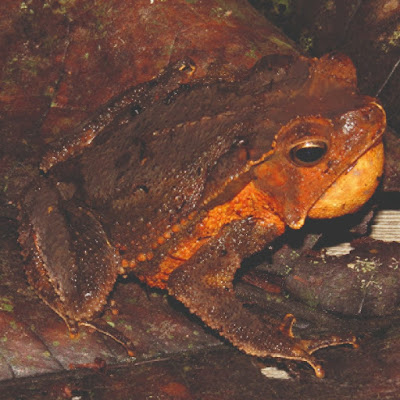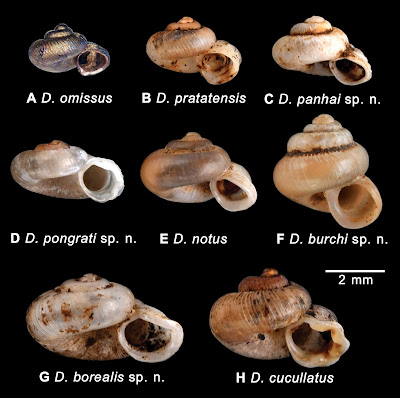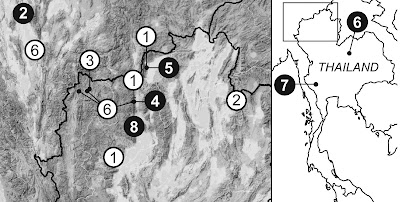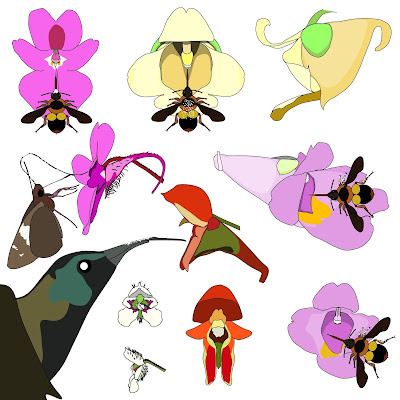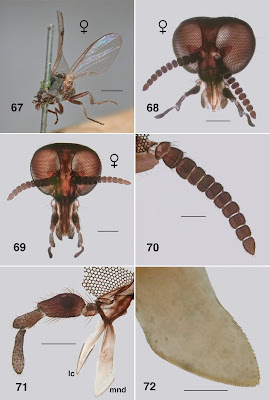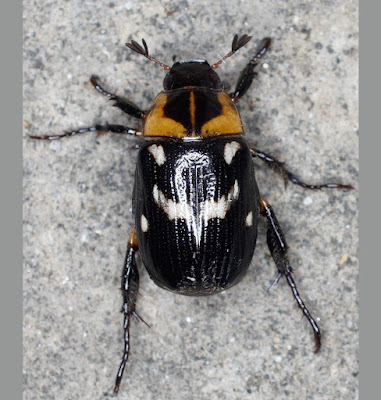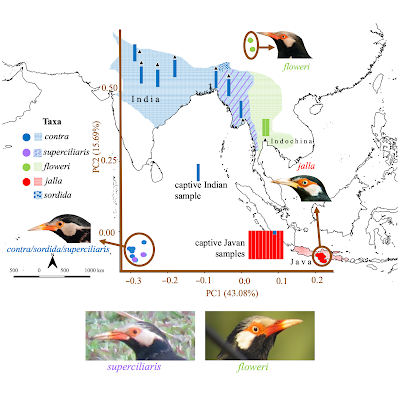[Most Recent Entries] [Calendar View]
Monday, January 11th, 2021
| Time | Event | ||||||
| 1:58a | [Herpetology • 2020] Rhinella exostosica • A New Species of Leaf-litter Toad of the Rhinella margaritifera Species Group (Anura: Bufonidae) from Amazonia
Abstract We describe through integrative taxonomy a new Amazonian species of leaf-litter toad of the Rhinella margaritifera species group. The new species inhabits open lowland forest in southwest Amazonia in Brazil, Peru, and Bolivia. It is closely related to a Bolivian species tentatively identified as Rhinella cf. paraguayensis. Both the new species and R. paraguayensis share an uncommon breeding strategy among their Amazonian congeners: each breeds in moderate to large rivers instead of small streams or ponds formed by rainwater. The new species is easily differentiated from other members of the R. margaritifera species group by having a strongly developed bony protrusion at the angle of the jaw, a snout–vent length of 63.4–84.7 mm in females and 56.3–72.3 mm in males, well-developed supratympanic crests with the proximal portion shorter than the parotoid gland in lateral view, a divided distal subarticular tubercle on finger III, and multinoted calls composed of groups of 7–9 pulsed notes and a dominant frequency of 1,012–1,163 Hz. Recent studies have shown that the upper Madeira Basin harbors a megadiverse fauna of anurans, including several candidate species. This is the first member of the R. margaritifera species group to be described from this region in recent years, and at least two additional unnamed species await formal description.
Rhinella exostosica, new species Etymology.— The specific epithet exostosica is derived from the Latin ‘‘exostosis’’ and a reference to the strongly developed bony protrusion at the angle of the jaw of the new species. Miquéias Ferrão, Albertina Pimentel Lima, Santiago Ron, Sueny Paloma dos Santos and James Hanken. 2020. New Species of Leaf-litter Toad of the Rhinella margaritifera Species Group (Anura: Bufonidae) from Amazonia. Copeia. 108(4); 967-986 . DOI: 10.1643/CH2020043 | ||||||
| 2:03a | [Mollusca • 2021] หอยคอคอดจิ๋ว • The Operculate Micro Land Snail Genus Dicharax Kobelt & Möllendorff, 1900 (Caenogastropoda, Alycaeidae) in Thailand, with Description of New Species
Abstract This study reviews the Dicharax species in Thailand. Altogether ten Dicharax species are reported, four of which are new to science and described herein. They are Dicharax borealis Jirapatrasilp & Páll-Gergely sp. nov., Dicharax burchi Jirapatrasilp & Páll-Gergely sp. nov., Dicharax panhai Jirapatrasilp & Páll-Gergely sp. nov. and Dicharax pongrati Jirapatrasilp & Tongkerd sp. nov. Alycaeus davisi Godwin-Austen, 1914 is regarded as a junior subjective synonym of Alycaeus cucullatus Theobald, 1870 (= D. cucullatus) based on a similar depressed-conical shell shape, a long sutural tube and a sharp swelling behind the peristome. Furthermore, the type locality of Alycaeus pratatensis Panha & Burch, 1997 (= D. pratatensis) had to be amended. Most important characters to distinguish Dicharax species are the general shell shape and relative lengths of teleoconch regions, whereas the spiral striation of R1, the shape of swelling of R3, the outer peristome crenulation and protrusion, and the exterior opercular sculpture show large intraspecific variability. Key Words: Cyclophoroidea, Gastropoda, Mollusca, taxonomy Family Alycaeidae Blanford, 1864 Dicharax Kobelt & Möllendorff, 1900 Type species: Alycaeus hebes Benson, 1857, by subsequent designation (Gude 1921: 236). Dicharax cucullatus (Theobald, 1870) Distribution: Shan State, Myanmar (Gude 1921), and Chiang Mai Province, Thailand. Dicharax notus (Godwin-Austen, 1914) Distribution: Shan State, Myanmar (Gude 1921), and Nan Province, Thailand. Dicharax omissus (Godwin-Austen, 1914) หอยคอคอดทรงกรวยต่ำ Distribution: Border region between Thailand and Myanmar (Gude 1921), and Mae Hong Son Province, Thailand. Dicharax pratatensis (Panha & Burch, 1997) Distribution: Known only from Doi Chiang Dao, Chiang Mai Province, Thailand. Dicharax borealis Jirapatrasilp & Páll-Gergely, sp. nov. หอยคอคอดจิ๋วภาคเหนือ Diagnosis: Shell medium-sized (SH up to 2.7 mm, SW up to 4.4 mm), depressed-conical. Spire ca. 1/6 of shell height. R1 with regular ribs; R2 twice longer than R3; R2 with ca. 72 ribs. R3 with very low, elongated swelling. Aperture oval. Inner peristome thickened, with three very shallow indentations, always without parieto-columellar indentation. Outer peristome expanded, not reflected. Umbilicus round. Etymology: The specific epithet “borealis” refers to the occurrence of the new species from the northern mountain of Thailand. Distribution: Known only from the type locality in Chiang Mai Province, Thailand. Dicharax burchi Jirapatrasilp & Páll-Gergely, sp. nov. หอยคอคอดจิ๋วเบิร์ช Diagnosis: Shell small (SH up to 3.6 mm, SW up to 3.5 mm), conical. Spire ca. ½ of shell height. R1 with regular, strong ribs; R2 as long as R3; R2 with 36–43 ribs. R3 with either sharp and narrow or blunt and more elongated swelling in the middle of R3 or near aperture. Aperture round. Inner peristome blunt, slightly protruding. Outer peristome expanded (most conspicuously at the upper palatal position and near the umbilicus), reflected. Umbilicus partly or entirely covered by expanded outer peristome. Operculum multispiral. Etymology: In honor of Prof. John B. Burch, a prominent American malacologist, who, together with Prof. S. Panha, extensively studied the taxonomy and systematics of micro land snails of Thailand. Distribution: The new species is known from the type locality, Tham Phaya Nakharat, Khon Kaen Province, Northeastern Thailand. The other localities are Doi Chiang Dao, Chiang Mai Province and Ban Soppong, Mae Hong Son Province, Northern Thailand, and also from Shan State, Myanmar. Dicharax panhai Jirapatrasilp & Páll-Gergely, sp. nov. หอยคอคอดจิ๋วปัญหา, Diagnosis: Shell small (SH up to 2.4 mm, SW up to 3.1 mm), depressed-conical with triangular dorsal side and widened, sigmoid last whorl. Spire ca. 1/3 of shell height. R1 with regular, thread-like ribs; R2 twice shorter than R3; R2 with ca. 18 ribs. R3 with blunt central swelling. Aperture round. Inner peristome thick, protruding. Outer peristome expanded, not reflected. Umbilicus elliptical. Etymology: In honor of Prof. Somsak Panha, a prominent Thai malacologist and our beloved professor who initiated the taxonomic and systematic study of land snails and other terrestrial invertebrates in Thailand and surrounding areas of mainland Southeast Asia. Distribution: The new species is known only from the type locality in Kanchanaburi Province, Thailand. Dicharax pongrati Jirapatrasilp & Tongkerd, sp. nov. หอยคอคอดจิ๋วพงษ์รัตน์ Diagnosis: Shell medium-sized (SH up to 2.3 mm, SW up to 4.4 mm), lenticular, depressed-conical. Spire ca. ¼ of shell height. R1 with regular, thread-like ribs; R2 three times longer than R3; R2 with ca. 76 ribs. R3 strongly reduced, without swelling. Aperture round. Inner peristome with two shallow indentations. Outer peristome expanded, slightly reflected. Umbilicus elliptical. Operculum multispiral, with or without elevated lamella. Etymology: In honor of Pongrat Dumrongrojwattana, a Thai malacologist who has studied micro land snails of Thailand and was one of the collectors of this new species. Distribution: The new species is known only from the type locality in Chiang Mai Province, Thailand. Parin Jirapatrasilp, Barna Páll-Gergely, Chirasak Sutcharit and Piyoros Tongkerd. 2021.The Operculate Micro Land Snail Genus Dicharax Kobelt & Möllendorff, 1900 (Caenogastropoda, Alycaeidae) in Thailand, with Description of New Species. Zoosystematics and Evolution. 97(1): 1-20. DOI: 10.3897/zse.97.59143 หอยคอคอดจิ๋วชนิดใหม่ของโลกจากประเทศไทย ทีมวิจัยของหน่วยปฏิบัติการวิจัยซิสเทแมต 1) | ||||||
| 4:22a | [Botany • 2020] Evolution of Pollination Syndromes and Corolla Symmetry in Balsaminaceae Reconstructed Using Phylogenetic Comparative Analyses Abstract Background and Aims: Floral diversity as a result of plant–pollinator interactions can evolve by two distinct processes: shifts between pollination systems or divergent use of the same pollinator. Although both are pollinator driven, the mode, relative importance and interdependence of these different processes are rarely studied simultaneously. Here we apply a phylogenetic approach using the Balsaminaceae (including the species-rich genus Impatiens) to simultaneously quantify shifts in pollination syndromes (as inferred from the shape and colour of the perianth), as well as divergent use of the same pollinator (inferred from corolla symmetry). Methods: For 282 species we coded pollination syndromes based on associations between floral traits and known pollination systems, and assessed corolla symmetry. The evolution of these traits was reconstructed using parsimony- and model-based approaches, using phylogenetic trees derived from phylogenetic analyses of nuclear ribosomal and plastid DNA sequence data. Key Results: A total of 71 % of studied species have a bee pollination syndrome, 22 % a bimodal syndrome (Lepidoptera and bees), 3 % a bird pollination syndrome and 5 % a syndrome of autogamy, while 19 % of species have an asymmetrical corolla. Although floral symmetry and pollination syndromes are both evolutionarily labile, the latter shifts more frequently. Shifts in floral symmetry occurred mainly in the direction towards asymmetry, but there was considerable uncertainty in the pattern of shift direction for pollination syndrome. Shifts towards asymmetrical flowers were associated with a bee pollination syndrome. Conclusion: Floral evolution in Impatiens has occurred through both pollination syndrome shifts and divergent use of the same pollinator. Although the former appears more frequent, the latter is likely to be underestimated. Shifts in floral symmetry and pollination syndromes depend on each other but also partly on the region in which these shifts take place, suggesting that the occurrence of pollinator-driven evolution may be determined by the availability of pollinator species at large geographical scales. Keywords: Asymmetry, floral morphology, floral symmetry, Impatiens, Hydrocera, molecular phylogenetics, pollinator Saroj Ruchisansakun, Arne Mertens, Steven B Janssens, Erik F Smets and Timotheüs van der Niet. 2021. Evolution of Pollination Syndromes and Corolla Symmetry in Balsaminaceae Reconstructed Using Phylogenetic Comparative Analyses. Annals of Botany. 127(1); 267–280. DOI: 10.1093/aob/mcaa184 | ||||||
| 9:12a | [Entomology • 2018] Diversity of Saproxylic Dance Flies and Long-legged Flies (Diptera: Empidoidea) in A Temperate Deciduous Forest in Quebec, Canada A large diversity of saproxylic Empidoidea from a temperate deciduous forest in southern Quebec is documented. Adults of 43 empidoid species representing 19 genera in 12 subfamilies and three families were collected from in situ sealed emergence traps placed over decayed logs of American beech (Fagus grandifolia Ehrhart) and sugar maple (Acer saccharum Marshall). The results of this technique give a clear indication of the saproxylic larval and pupal habitat of these species. The importance of Empidoidea as larval predators in decayed wood niches is noted. Keywords: Diptera, Dolichopodidae, Empididae, Hybotidae, emergence trap, American beech, sugar maple, larval habitat Jeffrey M. Cumming, Bradley J. Sinclair, Scott E. Brooks, Julia J. Mlynarek and Terry A. Wheeler. 2018. Diversity of Saproxylic Dance Flies and Long-legged Flies (Diptera: Empidoidea) in A Temperate Deciduous Forest in Quebec, Canada. Zootaxa. 4521(2); 287–293. DOI: 10.11646/zootaxa.4521.2.10 | ||||||
| 9:40a | [Entomology • 2018] Protaustrosimulium gen. nov. • A New Genus for Four Species of Australian Black Flies (Diptera: Simuliidae)
Abstract Protaustrosimulium n. gen. is described for four species: two previously named species from southeastern Australia—Paracnephia pilfreyi (Davies & Györkös 1988) and Paracnephia terebrans (Tonnoir 1925)—plus two newly described ones from the southwestern-most corner of Western Australia—Prot. amphorum n. sp. and Prot. opscurum n. sp. Molecular and morphological data suggest a close relationship between members of the new genus and Austrosimulium Tonnoir 1925. Monophyly of Protaustrosimulium is supported mainly by characters of adult females, as two of the four species are known only in that life stage. Two species groups are recognized: the pilfreyi-group for Prot. pilfreyi and Prot. amphorum, and the terebrans-group for Prot. terebrans and Prot. opscurum. The constituent species in each group are distributed vicariously in southeastern and southwestern Australia—a common biogeographical pattern in Australian simuliids. Keywords: Gondwana, Australia, Diptera, Simuliidae, Cnephia, Paracnephia
Douglas C. Currie, Douglas A. Craig and John K Moulton. 2018. A New Genus, Protaustrosimulium, for Four Species of Australian Black Flies (Diptera: Simuliidae). Zootaxa. 4521(3); 301–334. DOI: 10.11646/zootaxa.4521.3.1 | ||||||
| 9:49a | [Botany • 2019] Sacciolepis chantaranothainiana (Poaceae) หญ้าศอน้อย • A New Species from northeastern Thailand
ABSTRACT A new species apparently endemic to Thailand, Sacciolepis chantaranothainiana is described and illustrated. The conservation status is evaluated using the World Conservation Union (IUCN) criteria. KEYWORDS: new species, Phu Kradueng National Park, Sacciolepis Nash, Thailand 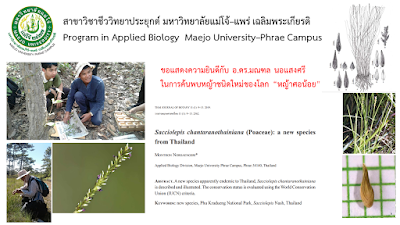 Monthon Norsaengsri. 2019. Sacciolepis chantaranothainiana (Poaceae): A New Species from Thailand. THAI JOURNAL OF BOTANY. 11 (1): 9–13. | ||||||
| 10:27a | [Entomology • 2020] Anomala dianopicta & A. huangyuzhoui • Contribution to the Genus Anomala Samouelle, 1819 (Coleoptera: Scarabaeidae: Rutelinae) of China and Adjacent Regions. Part I: Descriptions of Two New Species and Remarks on Four Species
Abstract Two new species of the genus Anomala Samouelle, 1819 are described: A. dianopicta Zhao, new species from Yunnan and A. huangyuzhoui Zhao, new species from Hunan. New distributional records for Anomala bella Arrow, 1917, A. blaisei Ohaus, 1914, A. cyanipennis Lin, 1999 and A. granuliformis Lin, 1996 are presented. Keywords: Coleoptera, leaf chafer, Anomalini, Anomalina, Oriental Region Ming-Zhi Zhao. 2021. Contribution to the Genus Anomala Samouelle, 1819 (Coleoptera: Scarabaeidae: Rutelinae) of China and Adjacent Regions. Part I: Descriptions of Two New Species and Remarks on Four Species. Zootaxa. 4903(4); 578–590. DOI: 10.11646/zootaxa.4903.4.6 | ||||||
| 1:00p | [Ornithology • 2021] Using Historical Genome‐wide DNA to Unravel the Confused Taxonomy in A Songbird Lineage that is Extinct in the Wild Abstract Urgent conservation action for terminally endangered species is sometimes hampered by taxonomic uncertainty, especially in illegally traded animals that are often cross‐bred in captivity. To overcome these problems, we used a genomic approach to analyze historical DNA from museum samples across the Asian Pied Starling (Gracupica contra) complex in tropical Asia, a popular victim of the ongoing songbird crisis whose distinct Javan population (“Javan Pied Starling”) is extinct in the wild and subject to admixture in captivity. Comparing genomic profiles across the entire distribution, we detected three deeply diverged lineages at the species level characterized by a lack of genomic intermediacy near areas of contact. Our study demonstrates that the use of historical DNA can be instrumental in delimiting species in situations of taxonomic uncertainty, especially when modern admixture may obfuscate species boundaries. Results of our research will enable conservationists to commence a dedicated ex situ breeding program for the Javan Pied Starling, and serve as a blueprint for similar conservation problems involving terminally endangered species subject to allelic infiltration from close congeners. Keywords: Asian Pied Starling, Asian Songbird Crisis, conservation genetics, museum samples, South‐East Asia, target enrichment, wildlife trade Pratibha Baveja, Kritika M. Garg, Balaji Chattopadhyay, Keren R. Sadanandan, Dewi M. Prawiradilaga, Pramana Yuda, Jessica G. H. Lee and Frank E. Rheindt. 2021. Using Historical Genome‐wide DNA to Unravel the Confused Taxonomy in A Songbird Lineage that is Extinct in the Wild. Evolutionary Applications. DOI: 10.1111/eva.13149 |
| << Previous Day |
2021/01/11 [Calendar] |
Next Day >> |
